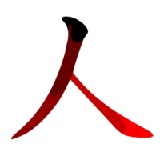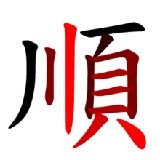 Kanji
Writing Order Kanji
Writing Order
Kanji
writing order, typically referred to as stroke
order, (Chinese: 筆順 bǐshùn; Japanese: 筆順 hitsujun or 書き順 kaki-jun;
Korean: 필순 筆順 "pilsun" or 획순 畫順 "hoeksun") refers to the correct
order in which the strokes of a Chinese character are written. A
stroke is a movement of a writing instrument. Chinese characters are
used in various forms in the modern Chinese, Japanese, and in
Korean. They are known as hanzi in Chinese, kanji in Japanese, and
hanja in Korean languages. While these languages all utilize a
common set of characters, the rules governing stroke order may
differ in each language.
The number of strokes per character for most characters is between
one and thirty, but the number of strokes in some obscure characters
can reach as many as seventy. In the twentieth century,
simplification of Chinese characters took place in mainland China,
greatly reducing the number of strokes in some characters, and a
similar but more moderate simplification also took place in Japan.
The basic rules of stroke order within each language, however,
remained the same. |
 The
Chinese character meaning "person" (Mandarin
Chinese: rén, Cantonese Chinese: yàhn, Korean: in, Japanese:
hito, nin; jin). The character has two strokes, the first
shown here in dark, and the second in red. The black area
represents the starting position of the writing instrument. The
Chinese character meaning "person" (Mandarin
Chinese: rén, Cantonese Chinese: yàhn, Korean: in, Japanese:
hito, nin; jin). The character has two strokes, the first
shown here in dark, and the second in red. The black area
represents the starting position of the writing instrument. |
|
|
|
Basic rules of stroke order |
 1.
Write from left to right, and from top to bottom 1.
Write from left to right, and from top to bottom
As a general rule, characters are written from left to right, and
from top to bottom. For example, among the first characters usually
learned is the number one, which is written with a single horizontal
line: 一. This character has one stroke which is written from left to
right.
The character for "two" has two strokes: 二. In this case, both are
written from left to right, but the top stroke is written first. The
character for "three" has three strokes: 三. Each stroke is written
from left to right, starting with the uppermost stroke:
This rule applies also to more complex characters. For example, 校
can be divided into two. The entire left side (木) is written before
the right side (交). There are some exceptions to this rule, mainly
occurring when the right side of a character has a lower enclosure
(see below), for example 誕 and 健. In this case, the left side is
written first, followed by the right side, and finally the lower
enclosure.
When there are upper and lower components, the upper components are
written first, then the lower components, as in 品 and 襲. |
 2.
Horizontal before vertical 2.
Horizontal before vertical
When strokes cross, horizontal strokes are usually written before
vertical strokes: the character for "ten," 十, has two strokes. The
horizontal stroke 一 is written first, followed by the vertical
stroke → 十. |
 3.
Cutting strokes last 3.
Cutting strokes last
Vertical strokes that "cut" through a character are written after
the horizontal strokes they cut through, as in 書 and 筆.
Horizontal strokes that cut through a character are written last, as
in 母 and 海. |
 4.
Diagonals right-to-left before diagonals left-to-right 4.
Diagonals right-to-left before diagonals left-to-right
Right-to-left diagonals (ノ) are written before left-to-right
diagonals (乀): 文. |
 5.
Centre verticals before outside "wings" 5.
Centre verticals before outside "wings"
Vertical centre strokes are written before vertical or diagonal
outside strokes; left outside strokes are written before right
outside strokes: 小 and 水. |
 6.
Outside before inside 6.
Outside before inside |
 Outside
enclosing strokes are written before inside strokes; bottom
strokes are written last: 日 and 口. This applies also to characters
that have no bottom stroke, such as 同 and 月. Outside
enclosing strokes are written before inside strokes; bottom
strokes are written last: 日 and 口. This applies also to characters
that have no bottom stroke, such as 同 and 月. |
 7.
Left vertical before enclosing 7.
Left vertical before enclosing
Left vertical strokes are written before enclosing strokes. In the
following two examples, the leftmost vertical stroke (|) is written
first, followed by the uppermost and rightmost lines (┐) (which are
written as one stroke): 日 and 口. |
 8.
Bottom enclosing strokes last 8.
Bottom enclosing strokes last
Bottom enclosing strokes are always written last: 道, 週, 画. |
 9.
Dots and minor strokes last 9.
Dots and minor strokes last
Minor strokes are usually written last, as the small "dot" in the
following: 玉. |
|
|
|
There are various ways to describe the stroke order of a
character. Children learn the stroke order in courses, as
part of writing learning. Various graphical representations
are possible, most notably successive images of the
character with one more stroke added (or changing color)
each time, numbering strokes, color-coding, fanning,[9] and
more recently animations. Stroke order is often described in
person by writing characters on paper or in the air. |
|
|
|
A few examples |
 Stroke
order for character 筆 shown by shade going from black to
red. Stroke
order for character 筆 shown by shade going from black to
red. |
 Stroke
order for each component (川 and 頁) of the character 順 shown
by shade going from black to red. Stroke
order for each component (川 and 頁) of the character 順 shown
by shade going from black to red. |
 The
character has two strokes, the first shown here in dark, and
the second in red. The black area represents the starting
position of the writing instrument. The
character has two strokes, the first shown here in dark, and
the second in red. The black area represents the starting
position of the writing instrument. |
|
 Japanese
Hiragana Katakana Kanji
Japanese
Hiragana Katakana Kanji
 The
Chinese character meaning "person" (Mandarin
Chinese: rén, Cantonese Chinese: yàhn, Korean: in, Japanese:
hito, nin; jin). The character has two strokes, the first
shown here in dark, and the second in red. The black area
represents the starting position of the writing instrument.
The
Chinese character meaning "person" (Mandarin
Chinese: rén, Cantonese Chinese: yàhn, Korean: in, Japanese:
hito, nin; jin). The character has two strokes, the first
shown here in dark, and the second in red. The black area
represents the starting position of the writing instrument. Stroke
order for each component (川 and 頁) of the character 順 shown
by shade going from black to red.
Stroke
order for each component (川 and 頁) of the character 順 shown
by shade going from black to red.